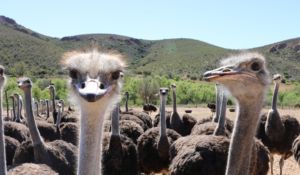Get to know the fabled, flightless African Ostrich as you’re likely to meet them when you travel through Africa with us. They enjoy running along beside you as Robin Kierstead discovered on the Victoria Falls to Cape Town trip.
16 Fascinating Facts about the Flightless, Fearsome African Ostrich
 Ostriches are the largest of 8.600 bird species that exist today. They stand at an average height of 2.1 metres/7 feet and weigh 100 to 135 kg/220 to 300 lb.
Ostriches are the largest of 8.600 bird species that exist today. They stand at an average height of 2.1 metres/7 feet and weigh 100 to 135 kg/220 to 300 lb.
- Ostriches feed on grass, succulents, berries and seeds. Their diet also includes insects and small lizards. They swallow large numbers of pebbles which help grind harder food and aid in digestion. Dinosaur fossils have revealed small pebbles where the gizzard would have been, suggesting a direct lineage between dinosaurs and modern birds.
- Predators include lions, hyenas, and cheetahs, which hunt them for meat, and humans who have hunted them for feathers and brought them close to extinction. Hyenas and lions also devour ostrich eggs.
- Maximum top running speed is 70 kph/45 mph, which it can maintain for up to 30 minutes. They can cover 5 to 7 metres/10 to 16 feet per stride.
- These birds are long-lived, surviving in the wild for up to 40 years.
- Ostriches are the only bird to have two toes on each foot. This adaptation is thought to aid in their running speed and also creates a powerful defence mechanism. One powerful defensive kick, measuring 500 pounds per square inch, is enough to kill a lion or human.
- Ostriches males make a deep booming sound that may be confused with the distant call of lions.
- Long necks enable them to sight enemies from a great distance. They share what they learn from this early warning system to protect themselves and other plains animals.
- Those same long necks make drinking difficult so ostriches satisfy most of their water requirements through the food they eat.
- Their long necks, trachea, and wide nasal passages are believed to cool exhaled air, reducing water vapour content to 87 percent. This adaptation helps minimize dehydration.
- Ostrich eyes, with a width of 5 cm, are the largest of all birds. This gives them excellent vision and helps in self-defence.
- Their powerful wings may not get them airborne but are useful for aggressive and courtship displays. They also serve as umbrellas when it gets hot, shading their naked thighs and young chicks. Feathers also serve as blankets, keeping them warm during cool nights.
- Ostriches mate for life although the Alpha male may also mate with hens lesser than the dominant hen. All of the group’s hens place their eggs in the dominant hen’s nest, although hers have prominent centre place. Nests may hold 14 to 60 eggs. The mostly black-feathered male sits on eggs at night; the drab brown dominant female covers them during the day, camouflaging the nest. It’s usually the male that looks after young chicks until they can fend for themselves.
- Shiny, whitish ostrich eggs are the largest of all eggs—15 cm/6 inches long, 13 cm/5 inches wide and weigh 1.4 kg/3 pounds. They take approximately 35 to 40 days to hatch.
- Ostriches have been successfully domesticated and are now farmed throughout the world for meat, feathers, and leather for fashion accessories.
- Contrary to popular belief ostriches do not bury their heads in the sand. However, nesting females sometimes flatten their heads to the ground when threatened, blending with the background.
Resources:

